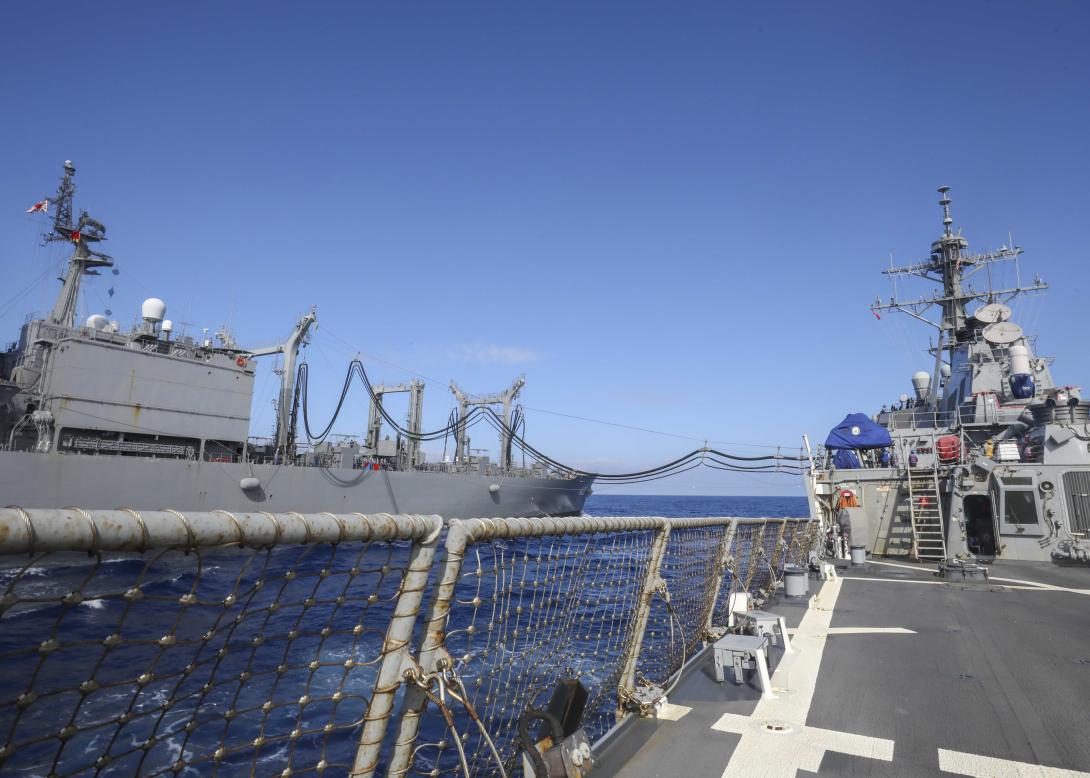Strengthening Alliances Is Critical for Tackling Shared Challenges
Today, more than ever, combatant commands, joint task forces, service components and supporting agencies need the mission partner environment to deliver the same capabilities envisioned for the U.S. Defense Department’s Joint All-Domain Command and Control concept. With two near-peer competitors dominating the defense strategy, the need for an enterprise-level mission partner environment has never been greater for promoting security cooperation while maintaining military readiness. As Cliff Fegert, former director of the Mission Partner Capabilities Office noted, “With two near peers, we do not have the luxury of preparation time, and we must have allies/partners to deter or win.”
In the Indo-Pacific area of responsibility, recent headlines only further highlight current and emerging threats to a free and open Indo-Pacific region. Advancements in hypersonic weapons, nuclear weapons technologies testing established treaties and regimes, and aggressive territorial posturing challenging international norms pose a greater threat to regional peace and stability. Strengthening alliances and partnerships into a capable, combined and joint all-domain force is critical for deterrence or decisive action across the spectrum of shared challenges.
Synchronizing the independent, if not disparate, efforts of the Defense Department, services, combatant commands and coalition partners to deliver a Joint All-Domain Command and Control (JADC2)-capable mission partner environment (MPE) that is both effective at the speed of war and cost-efficient is challenging. It is also essential. The current practice of allowing combatant commands or service-centric solutions sets conditions for higher risk in any future near-peer fight. Some of the most significant challenges to achieving the future state of MPE (and JADC2) include providing system of systems (SoS) interoperability across coalition and joint forces, ensuring enterprise-to-edge connectivity for global users and enabling data-centricity for accelerated decision making. The solutions to these challenges must provide highly available, resilient and global access across multiple classification levels, with assumptions of denied, degraded, intermittent or limited bandwidth environments.
The Defense Department’s JADC2 strategy will facilitate better solutions to unlock the power of data, fundamental for any command and control (C2) modernization efforts. Yet stronger alignment and synchronization from strategic and operational levels are required to accelerate decision advantage for coalition warfighters. This is reflected at the strategic level with the recent establishment of the Defense Department chief digital and artificial intelligence (AI) officer, who is charged with leading efforts to improve data-centricity, AI and digital solutions across the Defense Department. This should also help drive service and combatant command-acquisition efforts toward joint interoperability standards and open architecture solutions needed to implement the JADC2 and MPE reference designs, consistent with the Federated Mission Networking framework.
By design, the JADC2 strategy captures the need for a compatible MPE with the inclusion of line of effort (LOE) 5, Modernize Mission Partner Information Sharing. Lt. Gen. Dennis Crall, USMC, director, Command, Control, Communications and Computers/Cyber, and chief information officer, Joint Staff, J-6, described the MPE aspect of the JADC2 strategy as, “We are building in a mission partner environment as part of the organic conversation, not as an afterthought or a bolt-on later … We expect it to be a little more challenging, but we also know that we need it.”
Ongoing service and combatant command efforts contribute significantly to JADC2 and specific aspects of MPE. These include the Air Force Advanced Battle Management System, the Army’s Project Convergence, the Navy’s Project Overmatch and the Data-Centric Information Domain that is enabling the U.S. Central Command Partner Environment. However, these efforts tend to be discrete activities not fully synchronized under a centralized plan and indicative of the substantial risk to the future state of an MPE. The current distributed approach to building MPE capability outside a centralized Defense Department acquisition program provides great flexibility but dilutes direction and resource authority.
An option is to adopt campaign planning, the proven approach to keep complex, multifaceted efforts on track to achieve a strategy’s future state objectives across combatant commands and services. JADC2 and MPE would clearly benefit from the development of a functional campaign plan, potentially directed by the chairman of the Joint Chiefs of Staff, to translate strategic JADC2 and MPE guidance into activities executable by the services and combatant commands. The Mission Partners Capabilities Office (MPCO), charged with executing the secretary of the Air Force’s responsibilities as executive agent for the MPE, could coordinate the development of the campaign plan to organize, integrate, execute and assess significant MPE activities or capabilities supporting the JADC2 strategy.
The MPCO is responsible for designing, implementing, operating and sustaining a Defense Department-wide enterprise-level capability that supports joint and multinational warfighting functional information-sharing requirements with mission partners. In addition, the MPCO evaluates, recommends prioritization and incorporates requirements, capabilities and solutions for the integration and evolution of C2 and intelligence information-sharing capabilities in a coalition environment.
The MPCO also serves as the office of primary responsibility of the JADC2 strategy LOE 5 to reinforce synchronization of JADC2, Federated Mission Networking and MPE efforts. The MPCO’s material solution envisioned for MPE at strategic to operational levels is the secret and below releasable environment (SABRE). SABRE will federate combatant command or service component mission networks, such as the U.S. Central Command’s Partner Environment that was demonstrated at Bold Quest 2021, and the U.S. Indo-Pacific’s MPE, to be delivered through the joint warfighting network known as Indo-PACNET.
The MPCO is working to integrate and operationalize a prototype, SABRE v1.0, into a fully functional Defense Department zero-trust architecture cloud. SABRE will utilize identity, credential and access management and data labeling/tagging to achieve logical separation of data managed through enterprise-level data-centric security-based access controls. SABRE will also be the Defense Department cloud-based instantiation of a Federated Mission Networking-compliant MPE enterprise. The delivery of SABRE’s initial operational capability is a key component of the future state MPE and will help synchronize MPE across the data, technical and human enterprise LOEs of JADC2.
The MPCO is also charged with developing metrics and comparison benchmarks for overall MPE implementation and performance to determine specific areas for improvement. This role may be of equal, if not greater importance, than providing the operational SABRE.
The MPCO, as the implementing arm of the U.S. Air Force executive agent, should be fully resourced to develop and manage an MPE campaign plan. The plan would set the baseline and provide the road map for Defense Department agencies, services and combatant commands to organize, integrate, test, execute and assess MPE capabilities supporting the JADC2 strategy. The plan should be resource-informed, similar to combatant command campaign plans, constrained by the availability of resources and authorities and future requirements based on ongoing operations and planned activities. Services and CCMDs should develop supporting plans, and any partner nation-specific MPE objectives could cross-walk into the country-specific security cooperation section of the associated combatant command campaign plan.
The future state MPE will likely draw upon three foundational capabilities: 1) mission engineering, digital engineering and model-based systems engineering for SoS architecture; 2) data-centric architecture and data management; and 3) a hybrid/multicloud infrastructure. These should be LOEs as part of the MPE campaign plan and be included as requirements in future MPE acquisition efforts.
For the mission engineering LOE, the Defense Department’s mission integration management construct and technical sub-element of mission engineering would help drive the MPE campaign plan to deliver end-to-end MPE services mission-based engineered outputs. Mission engineering considers mission threads, which define the execution sequence of how systems, people, data, methods, tactics, timing and interfaces interact to achieve mission objectives. The MPE campaign plan should include a mission engineering LOE to direct development, management and repositories of MPE mission threads to facilitate services and combatant commands efforts.
Synchronizing SoS across applicable national and international data standards, dozens of mission threads and hundreds of applications or services within or supporting the MPE ecosystem is exceptionally complex. Standardized implementation of digital engineering and model-based systems engineering practices, tools and processes mitigate the complexity and facilitate decision making. The mission engineering LOE should include digital engineering and model-based systems engineering objectives with clear standards and implementation milestones.
The data management LOE is critical to provide coalition warfighters with decision advantage against near-peer adversaries. It must guide the rapid evolution of the MPE into a data-centric enterprise.
Established within a federated global data fabric, the MPE data-centric enterprise must manage the volume, variety, velocity and variability of data from diverse and growing sources available to coalition warfighters. The desired outcome for a data-centric enterprise is for seamless data feeds to all relevant coalition mission applications in all security domains to support unified action.
The MPCO can accelerate a data-centric enterprise by leveraging the ongoing work of the services, combatant commands and industry. The data management LOE should provide specific objectives and milestones for how data is collected, tagged, secured, enriched, visualized, analyzed, automated and distributed to authorized MPE user workstations or mobile devices.
Key milestones of the data management LOE should include implementing identity, credential and access management, attribute-based access control and a zero-trust architecture, such as the Defense Information Systems Agency Thunderdome project. Data must be accessible from traditional local area networks and wide area networks, as well as mobile communication or radio access technologies like 5G.
User experience in the data-centric approach is also important to MPE users, and the applications and automations that support users need to improve dramatically. There must be a revolutionary shift in user experience supported by machine learning (ML) and AI to more effectively share with mission partners.
The cloud LOE should guide the adoption of the evolving global cloud capabilities needed to provide coalition forces with assured data in times of infrastructure degradation. Cloud integration will occur at enterprise, regional and tactical levels. The complexity of implementing high levels of utility, performance, security and resiliency across hybrid and multiple cloud environments poses significant challenges. Resource constraints dictate that MPE cloud efforts capitalize on current or near-term Defense Department/service cloud offerings and leverage best practices for enterprise and expeditionary use cases.
MPE cloud LOE should continue to leverage the Defense Department Cloud Strategy, Defense Department Outside the Continental United States (OCONUS) Cloud Strategy and Joint Warfighting Cloud Capability objectives. It also must establish specific policy objectives and milestones for the MPE cloud to support information sharing with coalition partners. These objectives would provide the road map for how the enterprise will federate and control hybrid/multicloud approaches across multiple security domains, with access to any network or global infrastructure for the data needed to meet mission requirements.
The 2018 National Defense Strategy states, “We will strengthen and evolve our alliances and partnerships into an extended network capable of deterring or decisively acting to meet the shared challenges of our time.” In the four years since, this objective remains a work in progress. While the Defense Department has undertaken unparalleled efforts to implement JADC2 and MPE, these are complex, transformational endeavors requiring continued leadership by all MPE stakeholders. The department will not rapidly deliver a JADC2-capable MPE with an ad hoc approach. The U.S. Air Force/Mission
Partner Capabilities Office, empowered by the chairman of the Joint Chiefs of Staff and Joint Staff and in support of the other services and combatant commands, should develop an MPE campaign plan to guide resourcing and implementation decisions.
Finally, the Defense Department cannot achieve this MPE transformation alone. Collaboration with mission, coalition, industry and academic partners is critical to implement best practices and resolve the challenges faced by coalition warfighters as they defend nations every day.
Kirk Nilsson is a senior programs director for the Army and Missile Defense unit of the Integrated Defense Solutions business area within the Intelligence & Security sector of BAE Systems and a retired U.S. Army Special Forces colonel with over 30 years of service and extensive experience working with allied, coalition and partner nation forces during military operations and security cooperation activities.








Comments